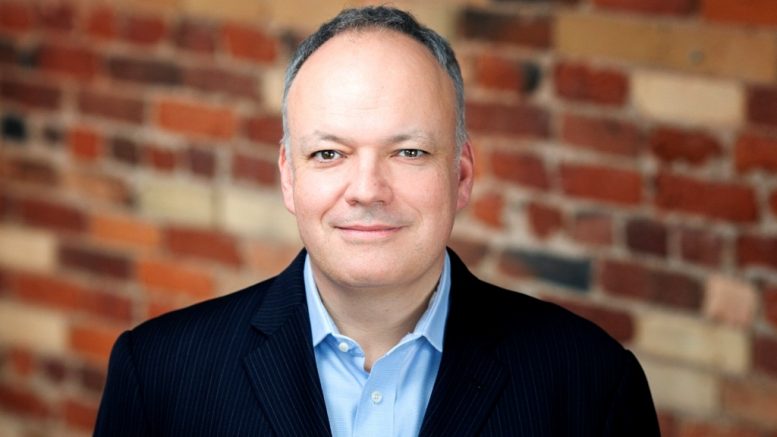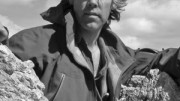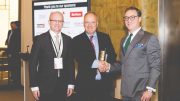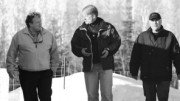In this feature interview, Matt Manson, president and CEO of Stornoway Diamond (TSX-SWY), reflects on his decade-long journey leading the company that transformed Renard from a grassroots exploration project in remote Quebec into the province’s first diamond mine — a feat that earned him our “Mining Person of the Year” award for 2016. (T.N.M., March 6-19/17)
The Northern Miner: Going back to the beginning, when you worked for Aber Diamond, how much of an influence was it on what you did later with Stornoway?
Matt Manson: I was working with Aber from 1997 as a consultant and then from 1999 as an employee, through into late 2004. I went through the process of doing the project financing for our share of Diavik. I was the Aber representative on the Diavik construction committee with Rio Tinto, and went through the set-up of all the operations.
We had a very specific business growth perspective back then, around 2002-03. It was very much Bob Gannicott’s vision: we were not going to operate Diavik. We were minority partners and we would only operate the sale of the diamonds.
We would become really good at that, and we became very invested in the downstream part of the business. We came to understand it, and I was in Antwerp for months on end.
That ethos eventually led us all the way down the pipeline to buy Harry Winston, and then turning the company into an integrated company with — as Bob described it — the bookends of the business: a mining investment and a retail investment.
I was fully onboard with the vision, but I was a mining guy, and by that stage, along with Bob himself, I was the last mining person in the company, essentially.
I wanted to stay in mining. I wasn’t cut out for the luxury goods business.
Agnico Eagle Mines was looking for someone to run a subsidiary called Contact Diamond that had diamonds assets in Ontario, in the Temiskaming area. I thought that was a good opportunity, so I said my farewells and left in late 2004.
Agnico was a fantastic bunch of guys to go and work with. And with this junior company Contact, they gave me a mandate to put some flow-through into it and do some exploration. But if I found a deal, they’d back it.
Immediately we began looking at the thing called Renard, which was the new Quebec diamond discovery, and Agnico was a Quebec-based gold miner.
We’d started to see how we could acquire an interest in that project. That led, in 2006, to my company Contact and the original Stornoway that was being run by Eira Thomas, putting our companies together and bidding for Ashton (Mining of Canada), which had 50% of the asset. Rio Tinto, as 51% owners of Ashton, wanted out, and everybody knew that.
We bought Ashton by locking up Rio Tinto, and then ended up consolidating all three companies.
When the bid was actually happening in 2006, people were scratching their heads. It looked like Stornoway buying Ashton and Stornoway buying Contact, and people were saying, who are these Contact Diamond guys, and why are they in the mixture?
But we were in the mix because it was our idea. We had Agnico Eagle in looking at Renard and they went through all the numbers. The Agnico team had done all the due diligence and we liked it. And Agnico, in that bid, put in $20 million into a $60 million war chest, that was our cash bid for that company.

Stornoway Diamond CEO Eira Thomas and president Matt Manson in 2008. Credit: Stornoway Diamond.
That’s sort of the path we’ve been on ever since. I always give credit at this stage of the story to the Ashton guys and to Soquem, because they found the asset. They did all the grassroots exploration for five years. They made the discovery in 2001. We were interlopers five years later, buying into it.
What we can claim credit for, since 2006, is getting the resource done, getting the economic studies done, getting the permitting done, building relationships with the Crees, getting it financed, getting it constructed, and putting it into production.
TNM: Well, that’s a lot! Now, you never had a major mining company as a partner, but you did have Agnico’s guidance from early on, and then Soquem as partner at Renard. Is that kind of the same thing, or was it different in some way?
MM: We had Agnico being very supportive of Stornoway. Whenever we raised any money, Agnico would come in for a piece of it with a lead order. So that was very useful.
David Garofalo, Agnico’s CFO at the time and now the CEO of Goldcorp, was on our board for many years. He left the board when he went to Hudbay Minerals, and then Ebe Scherkus, the president of Agnico at the time, came on board, and he’s still our chairman.
We always had this Agnico connection, and Sean Boyd has been very supportive. When I won the Viola R. MacMillan award in 2015 at the PDAC, the testimonial video for me which you can find online was all Agnico guys talking.
Soquem was really important, also. When we bought Ashton we inherited a 50-50 JV with Soquem, so they were very much equal partners.
An example of how important that was for us was, in the middle of the credit crisis, after we bought Ashton in 2006, we finished a bulk sample and put out the first resource and the first economic study, and it was skinny. We had a six-year mine life, a $60 million net present value.
After all the fuss and the hubbub we’d made with the hostile takeover of Ashton, to come out with a skinny project in the middle of nowhere, in the middle of the credit crisis… That was in November of 2008.
And by Christmas of 2008, the stock was at five and half cents and we were very depressed and running out of cash, and I had a very good CFO who was hiding money from me, so we’d have enough money to lay off all the employees.
That was a life or death moment for the company, and that’s when I became the CEO. Out of the gate in 2006 Eira was CEO and I was the president, and then she had her first child in the middle of that, in January 2009, I think her first child was born. So she stepped back to take a maternity leave and I became the CEO, and then she came back after maternity.
Soquem was really important in that moment, because the only cash that we could raise at Stornoway was Quebec super-flow-through, which meant we were drilling from surface in Quebec.
We decided, what the hell, we’re going to drill this orebody and see if we could make it bigger. For the drilling budget, we had $3 million in flow-through and Soquem chipped in $3 million to match.
So we had a $6 million drilling program and off we went. And in 2009 we had a home run.
That drill program saved the company because we discovered these orebodies were not tapering at depth as kimberlites are supposed to do, but were flaring open. The Renard pipes are like tubes, with Renard 2 being a big tube with a bulge in the middle. We discovered that bulge in the drilling in 2009 and that drill program tripled the size of the resource.
By 2010 we had a new economic study out, and the six-year mine life was now 18 years, and the $60 million NPV was now $600 million.
The Soquem relationship was really important for us, always. And it was a very good and friendly relationship. We bought Ashton by hostile takeover, but they were quite happy to see us come in as project operators and partners.
And that good relationship culminated in 2011 when they sold their project interest to us for equity in Stornoway. That’s why Investissement Quebec is such a big shareholder of Stornoway, because Soquem is their exploration vehicle. So essentially, Soquem is still there as a partner, just from within Stornoway now. They’ve been on our board and have contributed to project financing, and have been very big supporters.
TNM: That 2009 drilling campaign seemed like such a gamble at the time. Did you have some kind of prior indication that these pipes would bulge like they do, or were you just rolling the dice?
MM: No, we had very scant drilling at depth, and we knew we had drawn the orebodies fairly conservatively at depth. We thought that maybe we’d be able to get the mine life to eight or nine years by fattening up the orebodies a little bit at depth.

Exploration camp at Stornoway Diamond’s Renard property in 2007. Credit: Stornoway Diamond.
But then we discovered that at one level in the kimberlite, it’s kind of kidney-bean shaped. And one of the older Ashton drill holes had actually gone through one part of the kidney bean and stopped in waste rock in the middle of the kidney bean. And that drill hole, if it had gone 5 metres more, would have gone into the other side of the kidney bean and kept on going.
We actually redrilled that hole and found that. We got into the orebody five metres further on, and then went for 170 metres more in high-grade kimberlite before we left the orebody again.
We realized the original drilling — which was very scant, with one vertical hole and one cross hole — was only one part of the overall footprint of the orebody.
The adage in mining: “if you’re in a pickle, drill” — is true. Mining is a risk- and luck-based business, and you don’t get lucky unless you’re prepared to drill and search for something. And we got lucky in 2009, for sure.
TNM: Stornoway has undergone this tremendous shift from explorer to developer to mine operator. Was there a time when you knew you’d be mining it yourself? Did you originally develop it thinking you’d sell it at some point?
MM: To tell you the truth, we didn’t really have the option to sell it. Rio Tinto had sold to us, so they weren’t buyers. The other potential buyers in the business didn’t have the inclination.
The diamond business suffers in that it is a small pond, and we’ve all been swimming in each other’s company for far too long, and everyone has pretty nasty, prejudicial views of everybody else’s assets. And that’s why you rarely see any corporate activity in the diamond space.
We always wanted to develop it ourselves, and always said we were going to operate it ourselves. But nobody every came over the hill and gave us an offer we couldn’t refuse. If somebody had, of course, we would have taken it — that’s our responsibility.
But no, we were always on the path of doing it ourselves and that never changed.
TNM: As a CEO, how do you transition your workforce from explorer to developer to miner?
MM: We’ve kind of just grown. We’ve still got the core of the exploration group in Vancouver. We inherited a very big exploration group from Ashton of about 45 people, and we’ve reduced that over the years, as that was too much.
A lot of those guys went to Peregrine Diamonds, people like Catherine Fitzgerald. Another is John Armstrong, who is the resource guy at Lucara Diamond.
But the core of the group under Robin Hopkins is still there at Stornoway.
We relocated the head office in 2012 from Vancouver to Montreal, and we had previously hired a mine builder in a guy named Pat Godin, who is our chief operating officer, in 2010.
And Pat has been very influential in the company, because he has built the operating Stornoway around him in that head office in Montreal.
We deliberately repositioned Stornoway over a space of two and a half years from being a Vancouver-based, Anglophone exploration company to being a Montreal-based, Francophone mining company.
The vestiges of the original company are still there, but there’s been a cultural sea-change. Our board has evolved over that period and investor base has evolved, and that was a stepwise exercise over a two-year period.
TNM: Going back to that incredible financing, which was the largest-ever project financing package for a publicly listed diamond mining company, how did you cobble that together?
MM: We were in the trenches. It was 2011 and we had a good project. We knew we could build it but we had a lousy market cap, and we started going down the path of traditional mine project financing, which is basically half debt and half equity, with a cost overrun facility that’s equity based.
We had no problem arranging the debt. We had seven commercial banks that we were negotiating with in a syndicate. And we had an indicative term sheet for about $450 million of senior debt. But that was going to require us to do the same amount of equity, plus about another $150 million equity cost overrun.
So we were facing about a $600-million equity raise and our market cap was about $120 million. And that’s where we were getting stuck.
As we were scratching our heads on that one in late 2011 and early 2012, BHP decided to sell the Ekati mine and start a public process. We were bidders, and we were very low on the radar, and nobody really knew we were there, apart from a little bit of media.
By the spring of 2012, we got to the final short list, where there were four companies. Two bids went in finally: ours and Dominion Diamond’s. Ours was fully financed with private equity and bank debt, with Scotia advising us.
And we lost. Dominion Diamond won it.

The main camp at Dominion Diamond’s majority-owned Ekati diamond mine in the Northwest Territories. Credit: Dominion Diamond.
That story isn’t really well known. But coming second opened a whole bunch of doors for us, because there were eleven or twelve bidders originally in that process — a whole bunch of private equity guys, and different teams were assembling, and it was a big old process.
That summer and fall of 2012 we began to have serious discussions with potential financiers and private equity guys on different types of structure to finance Renard.
Because the reason we were bidding for Ekati was this: rather than raising all this money for Renard, why don’t we raise some money and do less equity and more debt to buy an existing operating mine like Ekati and then we’d be a mining company and that would give us a balance sheet, and then later we’d do Renard.
So Renard would become the development asset in the pipeline, after buying Ekati.
It was a very good strategy that almost worked out. All these doors opened in 2012 and we talked to all these private equity guys and different types of debt providers, banks and streamers and royalty companies.
That started a process that took another year, and then by late 2013 and early 2014, we had the deal set up that we wanted.
What was unique about our financing deal when we did it was how complicated it was. There were so many different pieces to it.
The penalty we paid for being a small cap company raising so much money — we were a $120-million market cap company raising $944 million — is that everybody needed to be the last money in, and everybody needed to have confidence that the other pieces of the puzzle were going to be done.
So the private equity, the public equity, the streaming deal, the senior debt facility, the convertible debt facility that was marketed, the cost-overrun facility and the equipment financing deal were all negotiated simultaneously, and launched simultaneously. And they were all co-dependent on all the other ones closing.
TNM: Good lord.
MM: Yes, so that was a horrendous process. But it worked. And we always said it worked because we managed to get a whole bunch of people that I called at the time “the coalition of good intent.” Everybody wanted the deal to work, and we just had to work out how that was going to go.
We had that all done by July 2014 and that got us into construction and that’s got us to where we are now.
TNM: Turning to the situation on the ground, you needed to build relationships with the local Cree, and then there was the Quebec government’s Plan Nord infrastructure program and the need to build a road to the mine site. How has all that evolved over the years?
MM: Ashton did a very good job before us in getting on the ground early and establishing relationships with the Cree and giving updates. So the engagement was very good when we came in in 2006. And we broadened and deepened that.
The Cree are very, very good. They are very sophisticated. There’s lots of capacity there in terms of skills and employment, and businesses in particular. Our two biggest contractors in the construction of the mine were both Cree businesses.
We did a confidentiality agreement during the Impacts and Benefits Agreement negotiations in 2011. We were under confidentiality, and they had our financial model. We had no fear of doing that, and the trust was good.
They struck a hard bargain but they were very commercially sensitive to what we were trying to achieve. And we tried to be as sensitive as possible to what they were trying to achieve. We got a good deal on reasonable terms, good for both parties, and a deal similar to Goldcorp’s deal with them on Éléonore.

At the Renard diamond mine site in Quebec, from left: Patrick Godin, Stornoway Diamond chief operating officer; Gerald R. Longchap, Deputy Chief of the Cree Nation of Mistissini; and Matt Manson, president and CEO of Stornoway Diamond. Credit: Stornoway Diamond.
The Crees have very good governance. They have two levels of government and they have very good leadership. They don’t have the problem of having a disenfranchised community. In so many aboriginal communities, the grassroots, the community members, are going in a different direction than the leadership.
And the leadership is who the mining company has to talk to, ultimately. And if the leadership is not enfranchised to talk to us by their communities, nothing ever happens, right?
The Cree doesn’t have that situation. They are much more politically mature. They’re completely straight ahead. They are very good people to work with, and are organized. They have a specific mining policy document that outlines what they are trying to achieve in terms of resource development. And there are some projects they don’t want to have: They didn’t want to have Strateco, they don’t want uranium mining.
They wanted to have us, and they wanted to have others. So they are very self-confident in what they want.
Our challenge with our social engagement is employment. There are actually competing employment options for the Cree in the James Bay area. There is Hydro-Quebec, the community corporations, and the band councils.
We have a hard time getting Cree employees into our management ranks because when we get them into our management ranks, we tend to lose them to other opportunities. That’s our principal challenge with that. In terms of business opportunities, spending in the communities, and social and environmental responsibilities, I think it’s gone very well.
TNM: And the road?
MM: Plan Nord was great timing for us, because we needed a road to the mine. We knew we couldn’t do a fly-in and winter roads in that part of the world are pretty unreliable because it’s just not cold enough in the winter.
There had been a mine in the area called the Eastmain gold mine, and it ran in the 1990s for six years, but it failed because the winter roads to that project failed one winter.
We needed a road, and the communities of Chibougamau and Mistissini had already planned out the road into our project, and had actually funded all the feasibility work. At the time there were four projects that were likely going to be built off that road: Strateco, Western Troy and their copper-moly project, the old Eastmain mine reopening, and us.
The road was shovel-ready when Premier Jean Charest launched Plan Nord in the summer of 2011.
We immediately put our hand up and we negotiated a cost-sharing agreement with the Quebec government under Plan Nord to get that road built. We were prepared to put money into the road, and they were prepared to finance our ability to do it, so they lent us the money to chip into the pool. And the work got started.

Signing the Plan Nord road agreement for the Renard diamond project in Quebec in August 2011, from left: Quebec Premier Jean Charest; Chibougamau Mayor Manon Cyr; and Stornoway Diamond president and CEO Matt Manson. Credit: Stornoway Diamond.
During that period, the three other mine projects in that area fell away. Eastmain never reopened. The copper-moly project that Western Troy had became a big shitshow because they made mistakes, and Troy ended up suing Genivar, which is still going on.
Then Strateco became a lawsuit because the Cree didn’t want uranium mining and that meant they didn’t get a permit from Quebec for a bulk sample. And that’s still going on in court.
We were the last man standing.
Quebec was very trusting in us, because we didn’t have our financing in place. We were trying to do our mine project financing off a small market cap and they were confident enough in us that we could do it to the extent that they were going to build a road.
That was a leap of faith on their part, but it all worked out pretty well. The road got built, the mine is operating, and we paid back the loan they gave us, and so far, so good.
TNM: Today, how would you characterize the mine operations, in a general sense?
MM: We were the only mine under construction in Eastern Canada in that period. We were able to come in five months ahead of schedule and that allowed us to come in a very acceptable amount under budget.
We’ve been ramping up since August. We are doing well with the resource. We are getting the grades and the tonnes and the diamonds we expect.
We are breaking diamonds in our process plant. We are telling everybody about the classic ramp-up problems that diamond mines have. The Ekati mine had the same problem in 1998.
Our process plant has been was experiencing a higher level of diamond breakage than we expected, so that’s a bit of a challenge, and affects the achieved price we’re getting.
But that’s a problem that’s fixable, and it’s our principal ramp-up, commissioning issue in the process plant. But we’ll get that sorted.

Aerial view of Stornoway Diamond’s Renard diamond mine in Quebec in 2016. Credit: Stornoway Diamond.

Cutting the ribbon at the official opening of Stornoway Diamond’s Renard diamond mine in north-central Quebec’s James Bay region, from left: Patrick Godin, chief operating officer; Ghislain Poirier, vice-president of public affairs; and Matt Manson, president and CEO. Credit: Stornoway Diamond.

Diamonds from Stornoway Diamond’s Renard mine in Quebec, on display during the opening ceremony on Oct. 19, 2016. Photo by Alisha Hiyate.
Our diamonds are being very well received. When you look at diamonds, the first couple of sales, people are a little cautious, they don’t know how it’s going to come out, how the stones are going to perform on the polishing wheels. They don’t know how the colour is going to change.
But there has been a change. The first two sales were cautious but the last two were terrific. We were healthily over our reserve pricing in every category.
But it’s early days for us and it’s going to take a little while to settle down — the same as with Diavik diamonds — but there are going to be Quebec diamonds in stores in the not too distant future, and that is encouraging.
TNM: When you look out at the mining world and see so many companies crash and fail, and CEOs come and go, how do you compare that with Stornoway and yourself, and what is your explanation for your staying power and sustained success?
MM: I think three things. The Renard asset is very good. A mining company succeeds based on the quality of the asset at the end of the day. Bad management groups can screw things up and good management can do well, but you’ve got have a good asset. The very best management group can’t do well with a lousy asset.
Number two I’d say is Quebec. Quebec’s always been a fantastic place to do exploration and to do work. And I don’t just mean institutionally, I mean the whole culture of mining in Quebec. It’s part of the economy, it’s part of the culture. Our contractors, the Crees, the whole thing is set up to help people like us succeed.
I’d say the third thing is the team, the investors, the board and the lenders. Stornoway is a very happy ship. We don’t have big fights on our board. We’re not firing people and getting into lawsuits all the time. We are pretty chunkily held, and we have long-time shareholders who are happy and have stuck with us.

Matt Manson, president and CEO of Stornoway Diamond. Credit: Stornoway Diamond.
And that’s not always the case. There are lots of examples of companies that are more conflict-based and dramatic.
We’re a pretty functional outfit, and I’ll give you a pretty good example of that. When we were in the trenches of doing our financing, the market only sees the deal that you do do. They don’t see the deals that you don’t do.
And we were getting all kinds of offers that were stinky deals at difficult times, and I took them to our board and major shareholders and told them, “This will get the project financed but it’ll be really punishing and terrible for shareholders. And I don’t think we should do it, however we have no other option — it’s the only deal on the table. The option is to take this, and all the pain, or to stay the course with no parachute and no plan B. We just have to keep trying and not take the bad deals.”
And the board always backed me up and the shareholders always backed me up. So if you have a happy ship and everybody’s working together, it’s a very good thing. And we’ve had that at Stornoway for many years now.
TNM: You’ve grown so steadily over the past decade. How do you go about building a team and getting people to complement each other?
MM: I believe in a traditional hierarchy in mining. When I worked for the original Aber with Bob Gannicott, he was much more entrepreneurial, creative and non-traditional in terms of management structure. It was much flatter with undefined roles.
I tend to follow the pattern of having everyone know what their job is and know who they are reporting to. I like to have competent people do their job, and delegate to them. I have a propensity to be involved in things, but I try to let people take responsibility and have a proper hierarchy.
I’m blessed by having a very, very competent chief operating officer, so my strategy with my COO is he has full authority over our relationships in Quebec, with the Cree and on the mine site. My relationship with him is, I let him do his job, and he tells me everything that’s going on. And that’s the fundamental key for our success working together. And that’s how I meant to do it.
— Please see our upcoming Diamonds in Canada issue for Matt Manson’s more in-depth, technical comments on the start-up of the Renard mine.






Be the first to comment on "Interview: Stornoway’s Matt Manson on the long road to production at Renard"